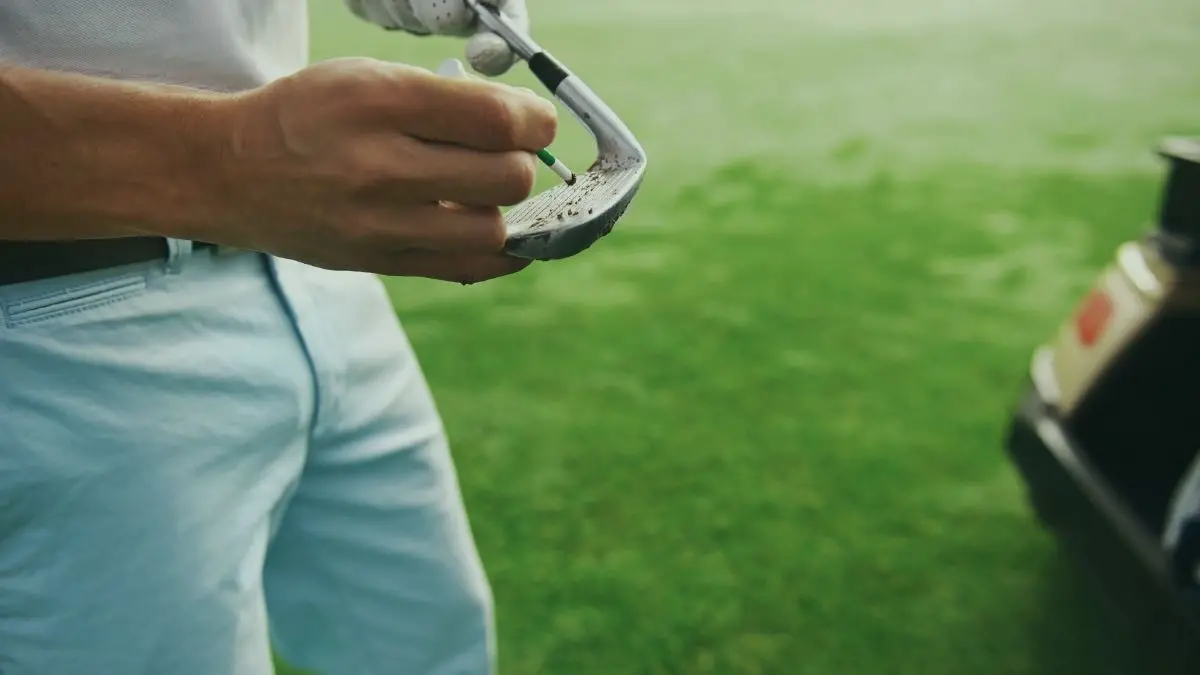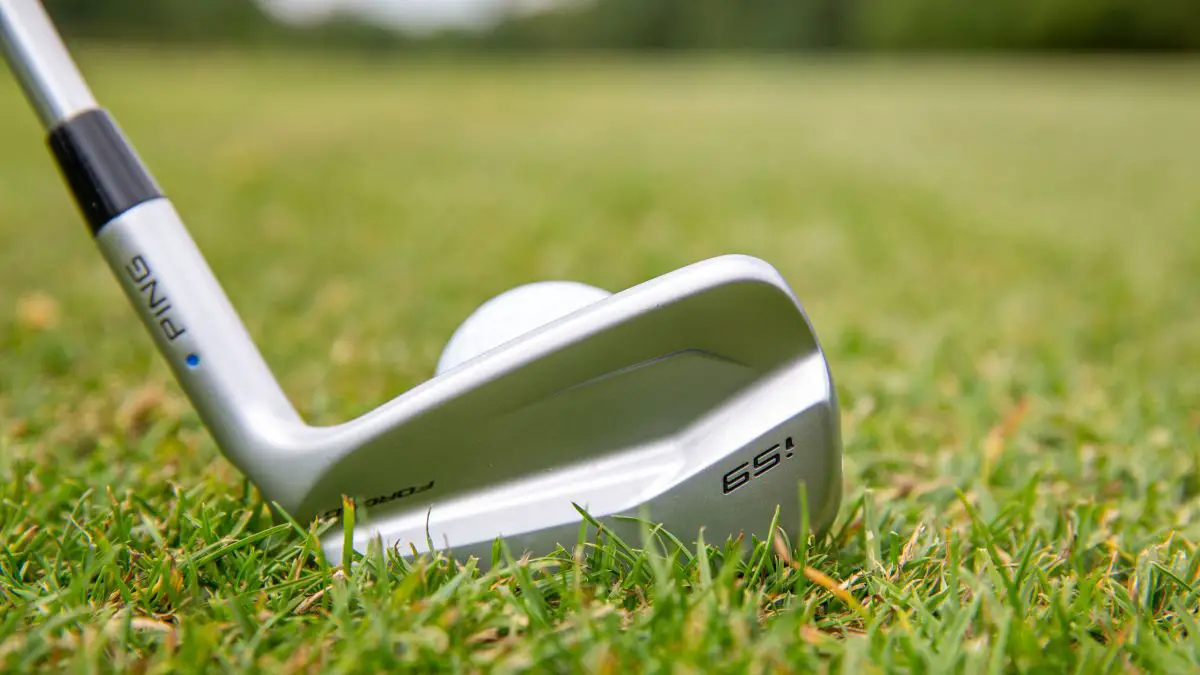Choosing the best golf club groove sharpener is important. Dirty golf grooves in irons and wedges will cost you ball control and will worsen your spin. In this article, we will explain how to choose the best golf groove club sharpeners to improve your game.

There are a few factors you need to consider when choosing the best golf club groove sharpener:
1. Type of Golf Groove Sharpener
2. Size of Golf Groove Sharpener
3. How Often You Will Use the Golf Groove Sharpener
4. Your Budget
Become A Pro At Maintenance With The Best Golf Groove Sharpeners
Type of Golf Groove Sharpener
There are three types of golf club groove sharpeners:
- diamond: used for cast irons
- copper: used on stainless steel clubs
- steel: used on all golf club types.
Diamond Golf Groove Sharpener Pros and Cons
Pros of Golf Club Diamond Groove Sharpeners:
- remove a lot of material quickly
- good for restoring the original shape of grooves
Cons of Golf Club Diamond Groove Sharpeners:
- can be difficult to use on some club heads
- creates a lot of sparks and heat
- can damage clubs if used incorrectly
Golf Club Copper Groove Sharpener Pros and Cons
Pros of Golf Club Copper Groove Sharpeners:
- easy to use, especially on stainless steel clubs
- less likely to damage clubs than diamond groove sharpeners
Cons of Golf Club Copper Groove Sharpeners:
- removes less material than diamond groove sharpeners
- does not restore the original shape of grooves as well as diamond groove sharpeners
Golf Club Steel Groove Sharpener Pros and Cons
Pros of Golf Club Steel Groove Sharpeners:
- easy to use on all types of golf clubs
- does not remove as much material as diamond or copper groove sharpeners
- restores the original shape of grooves as well as diamond and copper groove sharpeners
Cons of Golf ClubSteel Groove Sharpeners:
- cannot be used on cast irons
- generates a lot of heat and sparks.
Size of Golf Club Groove Sharpener
The size of the golf groove sharpener is important. You need to make sure that the sharpener is the same size or smaller the golf grooves on your club. If you are using a sharpener that is the same size or larger, you will damage your clubs.
For example, if you have 3 iron with golf grooves that are .020 wide and 2 inches long, you will need to find a golf groove sharpener that is about 2 inches long and .020 across its width.
If your golf club groove sharpeners is smaller than the equipment it's used on, it can easily slip out of place, causing more harm than good. For this reason, most people recommend choosing groove sharpeners similar in size to the golf grooves on your club.
How often you will use the Golf Groove Sharpener
When choosing a golf club groove sharpener how often plan to sharpen your clubs should also be a consideration. If you only plan to use your golf groove sharpener once or twice a year, it is not necessary to purchase the most expensive model. A less expensive model will do the job just as well.
Your Budget
The last factor you need to consider when choosing a golf club groove sharpener is your budget. Best golf club groove sharpeners range in price from around $10 to over $200. The more expensive models tend to have more features, such as the ability to sharpen other types of blades and longer warranties. However, if you are only going to use your golf groove sharpener occasionally, there is no need to spend the extra money on a more expensive model
How groove sharpeners improve your spin
Spin - especially backspin - is an important factor in controlling the ball, especially with irons and wedges. Because when you hit the green, it is the backspin that ensures that the ball bites and does not shoot over the green. The spin also helps with a high flight curve and a steep angle of arrival, which makes it easier to pass flags that are stuck behind bunkers or water hazards.
Many golfers mistakenly believe that the quality of their swing is the only factor responsible for generating spin. However, a big part of generating spin comes from having well-maintained grooves on your clubs. When you hit a ball with well-maintained grooves, it gets a better grip on the ball which in turn generates more spin.
Maintaining your clubs' grooves is therefore an important part of improving your game - and groove sharpeners make this process much easier.
As you can see, without a spin you lose control of the flight of the ball and deprive yourself of the chance to hit flags and get a good score. If you think you can't get backspin because your name isn't Dustin Johnson, Martin Kaymer, or Rory McIlroy, you are mistaken. Every golfer - regardless of their skill level - generates a backspin.
Use best golf club groove sharpeners to increase spin
However, many amateurs make life difficult for themselves and lose a lot of backspin - and therefore control - because they cannot keep their clubs in good shape.
Be honest and take a look at your club: Is there still the mud from the last round sticking, now dried and hardened? Is the face even a healthy rust-red hue? You can't start the new season successfully with equipment like this, let alone get spin on the ball.
The fact is that the grooves - the depressions in the face - have a decisive influence on the backspin generated. At the moment of impact, they literally grip the shell of the golf ball and create a lot of friction and spin. For high-quality golf balls with a urethane shell, this is even larger than for balls with a Surlyn shell.
Here are some stats. British YouTube blogger from Fried Eggs Golf made a direct comparison of clean and dirty grooves and came to extreme differences. The fresh grooves generated almost four times as much backspin as their filthy counterparts.
What should you learn from this finding? If you want to get the most out of your clubs - whether on the court or the range - you should clean your grooves before or after each shot. Whether with a wet towel, the tip of a tea, or a special groove club sharpener, cleaning your clubs and sharpening the grooves is a must.
But if you haven't cleaned your clubs for a long time and the dirt has settled, a thorough cleaning is due first.
How to clean the golf club groove sharpener
Step 1:
The best way to remove coarse dirt is to soak the clubs for a few minutes in lukewarm water with a few drops of the dishwasher.
Step 2:
You can then simply remove the coarse dirt with an old hand brush or a discarded toothbrush.
Step 3:
If there is still residual dirt stuck in the golf grooves, you can simply retighten the golf grooves using a golf groove sharpener or a wide sewing needle.
With these tips, your clubs are optimally prepared for the next round and you can count on the optimum spin when approaching the green as well as with bunker shots, chips, and pitches.
Just imagine how little spin you can get with old wedges and dirty grooves. Is it time for a new golf club groove sharpener?
Why do you need a golf club groove sharpener?
When you play often, the golf grooves on your irons and wedges can become dull and flattened. Same as the knives you use for cooking, keeping your grooves sharp improves your performance and adds preciseness to your shots.
Remember that thegolf grooves on your clubfaces provide a lot of friction and spin. When they are dull, you lose control over the ball because the shot will not fly as far and as straight as with sharp grooves.
With a dull groove, you either cannot start the golf ball or if you do, it quickly loses direction. The worst-case would be short shots where you go out of bounds or directly hit other players or spectators - something we all want to avoid!
Golf club groove sharpeners are sharp tools that work between the golf club grooves and keep them sharp. This way, your irons, and wedges stay sharp as in the brand-new club.
Golf club groove sharpeners are made of steel. The sizes are different in order to fit grooves of different sizes.
What features should I look for when buying the best golf club groove sharpener?
Before buying a new groove shaper, there are some things that need to be taken into consideration:
- Material: High-quality materials such as aluminum and stainless steel ensure high stability and durability. A good tool should be made of hardened steel.
- Design: The shape and design determine how easy it is to make the strokes. It has to fit comfortably in your hand and you should easily hold it while making the necessary strokes.
- Groove sharpening sizes: An all-purpose groove shaper can sharpen grooves of different depths, but specialty tools are designed for individual clubs that have grooves of different sizes.
How does a golf groove sharpener work?
Using this grooving tool on your clubs is simple and should take no more than ten minutes per club, especially if you are cleaning your golf clubs.
First, place the head of your golf club on a white towel. Examine the face of the golf club closely, looking for any residue in the grooves or notches in the face.
Tip: You can also run your fingernails over the golf grooves to test for sharpness, alternatively use a wire brush. If your golf grooves are sharp, your fingernails will make a distinct clicking sound.
If your grooves need sharpening, grab your golf groove sharpener by the handle and insert the blade at a slight angle so that the sharp edge faces the top of the groove.
Slide the blade firmly across the entire width of the groove and repeat the process on the underside of the groove. When you are finished, your golf club, irons and wedges should look noticeably cleaner than before.
What are the most common types of golf groove sharpeners?
There are two main types of golf club groove sharpening tools:
- Groove sharpening system for your home
- Portable golf club groove sharpener
The first type is fixed at a certain depth and has to be used with great caution. The second type is more comfortable because you hold it in your hands, but both tool types have their advantages and disadvantages.
Basically, there is no clear winner when it comes to the best type of golf groove sharpener. It depends on how often you plan to use them as well as if you want to carry along an additional traveling case or not.
Regardless of the type you choose, always make sure to use your golf groove sharpener properly. Keep your strokes short and firm, but do not hit too hard because that would ruin the geometry of the groove.
How much does a golf club groove sharpener cost?
Golf club groove sharpeners are rather inexpensive tools that can be bought for $5-20 depending on their quality. Even though the price often depends on how many grooves they fit, it is more important whether they fit all types of irons and wedges or not. A good tool should have at least three different grooves with different depths so that it can match nearly every iron or wedge available on market.
How to choose the best groove sharpener
High-quality groove sharpeners will produce the best results on your golf clubs, irons, and wedges. The grooving tool is designed to sharpen and clean your club grooves and extend the life of your golfing equipment.
After reviewing the best golf club sharpeners on the market, we found these distinct features that you should consider:
- The sharpener should be big enough and the grip on its handle should be comfortable to use.
- The tool should not slip from your hand and make you prone to injuries.
- The tool should sharpen all kinds of grooves perfectly, including both U-grooves and V-grooves.
- You should be able to use the groove sharpener on both irons and wedges.
- The golf groove sharpener should have a non-slip grip that would keep your fingers safe.
- Look for models with interchangeable heads that would give you the most bang for your buck.
- Find a model that comes complete with a grinding blade to make the sharpener really sharp.
- You should be able to obtain a reliable guarantee.
Conclusion
Clean and sharp grooves in your wedges and irons will give you the ultimate control of your ball and improve your spin. For the price of less than a bucket of golf balls, make sure you get that little extra you need for that epic golf swing with the best golf club groove sharpener.









